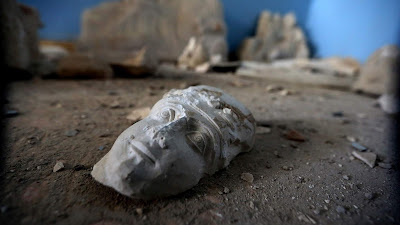Sunday, June 10, 2018 -  1970 UNESCO Convention,illicit art trade,Syria,UNIDROIT
1970 UNESCO Convention,illicit art trade,Syria,UNIDROIT
 No comments
No comments
 1970 UNESCO Convention,illicit art trade,Syria,UNIDROIT
1970 UNESCO Convention,illicit art trade,Syria,UNIDROIT
 No comments
No comments
Syria has ratified the 1995 UNIDROIT Convention on Stolen or Illegally Exported Cultural Objects.
 |
| The smashed face of a statue found on the floor of the Palmyra museum in the Syrian city of Tadmur, Homs Governate, March 31, 2016. Image Credit - Joseph Eid |
To address the ongoing issue of illicit trafficking of Syrian cultural property, the country has now ratified the UNIDROIT Convention on Stolen or Illegally Exported Cultural Objects. Adopted on 24 June 1995, representatives of over seventy states met in Rome with an ambitious goal aimed at harmonizing the rules of private law of various states parties affecting the restitution and return of cultural objects between states party to the Convention to their country of origin.
The aim of UNIDROIT (is clearly stated in Paragraph 4 of its preamble. That that is: to contribute effectively to the fight against the illicit trade in cultural objects by establishing common, minimal legal rules for the restitution and return of cultural objects between contracting states with the objective of improving the preservation and protection of cultural heritage.
At present, including Syria, there are now forty-three states party signatories to the Convention.
With Syria's deposit of the instrument of accession to the UNIDROIT Convention of 1995 at the Italian Ministero degli Affari Esteri e della Cooperazione Internazionale (Ministry of Foreign Affairs and International Cooperation) on 27 April 2018, the UNIDROIT Convention will enter into force for the Syrian Arab Republic on 1 October 2018.
The full text of the Convention is available here.
Extracted from the UNIDROIT website:
For years, many middle eastern countries failed to consider ratification of UNIDROIT working under the false assumption that the initiative for the Convention on the protection of cultural property was a manoeuvre by “art importing” countries to weaken the UNESCO Convention. Others (wrongly) misinterpreted the nature of the agreement as an extension of the UNESCO Convention at the behest of the “exporting” States. The reality is quite different as Marina Schneider, Senior Legal Officer and Treaty Depositary explains. In trainings conducted throughout the globe, Ms. Schneider explains that it was at UNESCO’s request that UNIDROIT (International Institute for the Unification of Private Law) took up the matter of illicit traffic in cultural movables given the enormous complexity of legislation as it relates to the phenomenon of illicit trafficking.
 |
| For a “live” status map of the Signatory and State parties to the UNIDROIT Convention please see the UNIDROIT website here: https://www.unidroit.org/status-cp?id=1769 |
The ratification of the UNIDROIT convention will allow Syria to fight more effectively, together with other signatory States, against theft, import, export and illegal transfer of ownership of its cultural patrimony. Let's hope Iraq will sign on next.
















